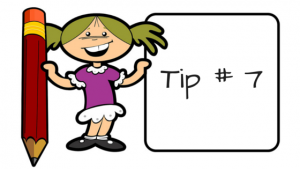
As a veteran English and Social Studies teacher, I’d like to share some effective proof-reading tips that I’ve used to help students improve their writing skills, and to make my life a bit easier.
 This is simple but a tough one for the kids to remember. When writing a rough draft they should skip a line between sentences. This will leave room for proof-reading comments. We are programmed to finish writing one line and just going to the next, so students will really need to remember this. I’ve often told them to use a marker or pen and put a dot at the beginning of each line that they should write on. This helps a great deal. Eventually they will get it and it will become second nature. Also, letting them know that as part of their final grade, they get credit for skipping lines on their rough draft.
This is simple but a tough one for the kids to remember. When writing a rough draft they should skip a line between sentences. This will leave room for proof-reading comments. We are programmed to finish writing one line and just going to the next, so students will really need to remember this. I’ve often told them to use a marker or pen and put a dot at the beginning of each line that they should write on. This helps a great deal. Eventually they will get it and it will become second nature. Also, letting them know that as part of their final grade, they get credit for skipping lines on their rough draft.
 Always write rough drafts with a pencil if not using a computer. At the top of their paper, the student should write each area that will be proof-read. This depends on what you are teaching at the time. After proof-reading has been finished, each student must initial the part that they corrected.
Always write rough drafts with a pencil if not using a computer. At the top of their paper, the student should write each area that will be proof-read. This depends on what you are teaching at the time. After proof-reading has been finished, each student must initial the part that they corrected.
 Proof-reading is a group effort, so I have the class get into their collaborative groups of 4. I will direct them and let them know exactly what to do. Each child will have a specific thing to look for, depending on
Proof-reading is a group effort, so I have the class get into their collaborative groups of 4. I will direct them and let them know exactly what to do. Each child will have a specific thing to look for, depending on  the lesson. If you’re using sensory words, descriptive adjectives, topic and detail sentences, capitals and end punctuation, figurative language etc. they will proofread accordingly. It is really up to the individual teacher. All corrections should be written in pen or different colored pencils. Here are some examples:
the lesson. If you’re using sensory words, descriptive adjectives, topic and detail sentences, capitals and end punctuation, figurative language etc. they will proofread accordingly. It is really up to the individual teacher. All corrections should be written in pen or different colored pencils. Here are some examples:
a. One child will make sure that the paper makes sense. They will read it and add corrections on the blank lines,
b. Another child will look for colorful words such as adjectives, sensory words.
c. Someone else will circle spelling errors with red.
d. The fourth child will fix punctuation and grammar. They might underline grammar mistakes, or circle them with a blue pencil.

Each member of the group begins with someone else’s paper. They have a certain amount of time to read and correct it, 10-15 minutes or so. When time is up, they give the paper to the next person, and they do their specific job. This continues until all the corrections have been completed. They must remember to initial the part they corrected see tip #2.
 Once the proof-reading has been finished, I let the class know that they will be reading each other’s paper to them to hear how it sounds. It’s easier to pick up mistakes when you hear it out loud, rather than reading it to yourself. This can get noisy, so they should use inside voices.
Once the proof-reading has been finished, I let the class know that they will be reading each other’s paper to them to hear how it sounds. It’s easier to pick up mistakes when you hear it out loud, rather than reading it to yourself. This can get noisy, so they should use inside voices.
a. When child A reads child B’s paper, child B has to listen, and visa versa. You do this for all papers in each group. If errors are picked up, they can be worked on, corrected and read aloud again.
 As an incentive, tell your kids that if a paper that they corrected has no mistakes, they will get extra points towards the final grade on their own paper. This will get the class to take this exercise seriously.
As an incentive, tell your kids that if a paper that they corrected has no mistakes, they will get extra points towards the final grade on their own paper. This will get the class to take this exercise seriously.
a. John, Sarah, Sally and Andrew are in group A. John fixed spelling errors on the papers in his group. No one has spelling mistakes, so I would give him 4 extra points, 1 point for each paper that has been proof- read. Do this for everyone in the group. Use your own discretion.
 When the final drafts are collected, they should include pre-writing, and rough drafts with comments and corrections. I let the them know that if they’ve followed directions and handed everything in as instructed, they will get credit for it.
When the final drafts are collected, they should include pre-writing, and rough drafts with comments and corrections. I let the them know that if they’ve followed directions and handed everything in as instructed, they will get credit for it.
Here are a few resources that you might be interested in




I love the concept of peer editing. I used it all the time in my classes. This post was very interesting. Happy Holidays!
These are great tips! I have my students skip lines & write on one side of the paper when drafting also, to leave space for revisions. Although I only let them write in pen so they don’t focus on erasing; just cross out and keep writing. I love the idea of having each student looking for something different in their group member’s drafts. I’m going to try this!
This was a great idea and very clearly explained.